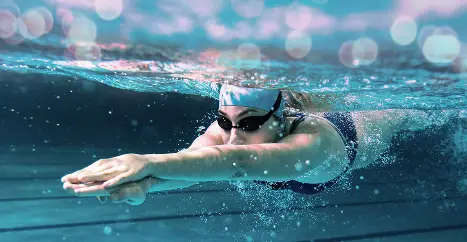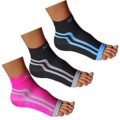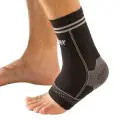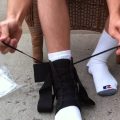*This page may contain affiliate links. When you buy through these links, we may earn a small commission at no extra cost to you.
Swimming is one of the best full-body workouts you can do to increase your strength, stamina, and overall well-being.
Like any physical activity, swimming and surfing can cause injuries or exacerbate existing ones.

Learning what to expect in terms of an injury and what to expect in terms of how to deal with the injury will get you back in the pool faster and keep you on your tight training schedule.
Be sure to listen to your body, stop when it needs to spot, and if something feels like it has popped or pulled, don’t be a hero.
Get out of the pool and do a system check on yourself and only jump back into your workout if you are comfortable doing so.
As always, check with your primary care physician to see if you are healthy enough to start using swimming as aerobic exercise.
If you are injured, check with your trainer or rehabilitation specialist before adding swimming to your recovery.
Causes of Ankle Pain after Swimming
While many of the injuries typical of swimming and surfing are found in the upper body, ankle pain from swimming is quite common as a lower-body injury.
The main root of ankle pain from swimming is the failure of the swimmer to relax the foot as it re-enters the water during their strokes.
An ankle joint held tightly slapped against the water in repetition throughout a workout will lead to increased pain.
It can lead to pain, but the more often you hold your foot tight throughout your stroke, the higher the likelihood is that you can hit your foot wrong, which could lead to a sprain.
This is no different than landing awkwardly in basketball or hitting the base awkwardly in baseball.
For more advanced training, when you flip and go to kick off the wall, it is possible that you hit your foot awkwardly or rolled it underwater as you went to turn and push off the edge of the pool and begin your return back down the pool.
Continuing once you hear a pop or feel pain along your ankle is not a sign of good training but a sign of ignoring one’s own needs.
3 Best Waterproof Ankle Brace for Swimming
Wearing an ankle brace for water sports like swimming, surfing, diving, and others can help your feet stay protected.
However, picking the right one that delivers maximum benefits can often be tough for athletes.
For your help, we have reviewed some of the best options available on Amazon. These are completely waterproof and are specifically designed for sporting in the water.
1- BraceAbility Neoprene Water-Resistant Ankle Brace

Neoprene Water-Resistant Ankle Brace by BraceAbility is best for swimmers, surfers, and divers.
Athletes who are into other water sports like water polo, scuba diving, wakeboarding, bodyboarding, wind boarding, skiing, sailing, rowing, etc. can also use this waterproofed ankle brace for guarding their feet.
The soft ankle wrap by BraceAbility is innovatively designed and is clinically proven to offer greater athletic support and protection from conditions like an ankle sprain, strains, swelling, instability, tendonitis, post-fracture recovery, etc.
The brace comes with 3/16” thick premium-grade neoprene material to offer you better compression and targeted heat retention. This also helps in improving the circulation around your sore ankle.
Also, its flexible figure-eight straps are highly adjustable to provide you optimal support when you are into water.
This water-resistant ankle brace is not only good for athletes but also for non-athletes.
No matter whether you spend most of your time sporting or just walking and running, you can use it for your daily activities for maximum ankle protection from swelling or pain.
2- Adjustable Ankle Support Compression Brace for Surfing

This high-quality ankle support compression brace is ideal for acute injuries such as muscle strain, ligament sprain, twisted ankle, rolled ankle, or for stabilizing the weakened ankle joints post-surgery.
The beauty of this waterproof ankle support is its open-heel design. This allows a wide range of motion during your play activity while providing maximum support for the ankle tendons and joints.
This comfortable ankle brace features breathable neoprene material (for retaining heat and preventing skin irritation), which is flexible, washable, and highly durable.
The brace also comes with high-grip crisscross straps (for customized tightness and bracing) and is good for indoor as well as outdoor sporting.
The best thing is you can use this single brace for both feet – up to 28cm (11″) in feet arch circumference.
3- Ankle Support Brace Elastic Compression Foot Wrap by JINTN

This elastic sleeve bandage for protecting your ankle is highly breathable and is one of the best fits for athletes in swimming, surfing, and diving.
With its effective compression and open heel design, it allows a wide range of motion during activity along with proper support to the ankle joints.
The brace can be worn risk-free for long hours and is good enough to prevent sudden stretch or strain to the injured tendon. Also, it helps to alleviate the conditions such as Achilles Tendinitis.
Perfect for various sports, this comfortable ankle brace provides you with the best performance without worrying about ankle injuries due to high-impact leg motions.
No matter whether you are into triathlon or sports like water aerobics, snorkeling, water polo, aqua jogging, etc these ankle protectors can help you a lot.
NOTE: Before you buy any of the above ankle support please measure the circumference of your heel around your ankle.
Also, refer to the sizing chart and check whether you want a brace for the left, right, or both feet.
What are Common Swimming Injuries?
As a strenuous athletic activity, swimming can lead to some injuries due to overexertion and a lack of stretching, among other issues.
The most common injury is inflammation or irritation of the shoulder joint. In addition to the shoulder pain, you can see additional damage done to the rotator cuff regarding tendonitis or tears.
In some cases, tears can lead to surgery, and in almost all cases, a tear will immediately halt training.
Shoulder impingement syndrome is common in frequent swimmers as it pertains to the rotator cuff and damage to the muscles around the shoulder blade due to the overhead swimming motions of the standard swimming technique.
Tears in this cartilage can also be a common occurrence in those who use swimming and surfing sports as a staple of their workout routine.
Neck and lower back pain can also occur as a result of the strenuousness of the swimming workout, and this will be especially true if the athlete does not take the pre-workout stretch properly.
Most of the swimming motion is made through the feet and arm (through the bicep). Overuse can lead to developing tendonitis in that area as well.
Few other body parts susceptible to injury due to swimming include the elbow, knee, hip, and ears. However, the injuries on these parts are less commonly seen.
How does Ankle Brace Help Swimmers And Surfers?
You should consider any and everything you can do to better protect your ankle.
If the ankle pain is persistent and causing you to stop training or slowing your training down, you should invest in a guard to help assist you during the time it takes you to properly guard yourself.
An ankle brace acts as a guard and will protect your ankles from the hard slap of the water at the end of each stroke.
Then if you are still sloppy during your rotations and push-offs, you can guard your foot to the best of your ability with a waterproof ankle brace.
This is no substitution for proper form, but it can serve as a stopgap between finding out the issue with your ankle and solving it.
The best way to work through issues in your form is to stay in the pool and focus on improving your muscle memory and turning the new form into second nature.
The best way to stay in the pool to learn this technique and become more conscious of just how you are injuring yourself is to pick up a swimming ankle brace and get back in the pool.
Do some laps to ensure you are capable of it and get back in the pool for good.
Few Ankle Pain Prevention Tips for Swimmers
Stretch before starting
The first way to help prevent ankle pain is to not neglect proper stretching before you begin exercising.
By stretching the ankle tendons and joints, you have warmed up the muscles and are not just jumping in the pool ice cold and putting a strain on already tight muscles.
Learn proper techniques
The next thing you can do is start studying proper technique or at least becoming more conscious of just how your foot is hitting the water on your stroke.
Just as you learned how to breathe during competitive surfing or swimming, you must now learn the proper technique when kicking the water at the conclusion of your stroke.
Keep yourself protected, and don’t hit.
When flipping and kicking off the other way, be sure to focus on hitting the wall square and pay attention to your surroundings so that you can hit the wall on a flat part.
Then, during your flip or roll, focus on properly tucking your feet so that they do not drag across the bottom of the pool or slap the top of the pool water with your feet tense instead of being properly relaxed so that they do not take on the repeated damage.
The conclusion
Swimming is a form of exercise that is very gentle on the muscles and ligaments. It aimed to make them as flexible as possible.
However, along with practicing and enjoying your swimming session every week, you need to guard your body parts like your ankle and feet, which are most vulnerable to getting an injury.
To get rid of all the stress and to enjoy your swimming session best, it’s good to invest in a high-quality swimming ankle brace rather than being sorry at the end of a bad day.
Incoming search terms:- waterproof ankle brace for swimming
- waterproof ankle brace
- scuba diving with ankle tendonitis






